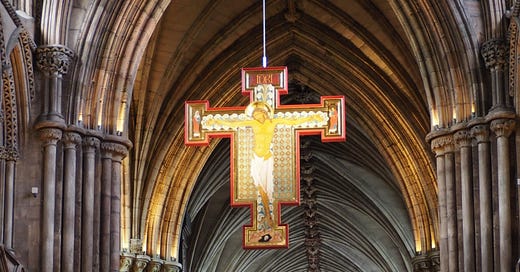At the peak of Dante’s spiritual and metaphysical ascent in the Divine Comedy, beyond hell, purgatory and even heaven itself, the poet finally discerns the apex which binds the cosmos: “the Love which moves the sun and other stars.”
This Love, of course, is God. But might we prosaic moderns not be more tempted simply to call it gravity? Surely to equate the indifferent forces which hold the universe together with anything as anthropocentric as love is wishful thinking, a category mistake. There can be no inherent connection between empirically verified physical realities and merely spiritual or at best psychological speculation.
Dante and his Platonic peers throughout the centuries would differ. They would hold that the gravitational pulls which hold matter in order are the expression of an order which transcends the physical, which we might well call both God and Love, and which is essential not only for our being, but for our well-being, too.
Thanks to atomising tendencies of late mediaeval philosophy mediated by certain romantic sensibilities, moderns tend most strongly to associate love with the freely willed expression of commitment. Our ideal of love is a relationship of equality between two individuals. The danger of this emphasis is that we mistake a part of love for the whole. So we deem the most loving society that which works towards the greatest equality of its members to one another. We are dismissive of the hierarchical order which our forebears attributed to the heavens, the world and, by participation in both, human society. Cosmic love for them was an equilibrium sustained only by radical inequality.
The pointed arch of the Gothic cathedral is exemplary of such coordinated inequality. Inherited from Islamic architecture, this structure allowed for what seemed to the mediaeval mind impossibly soaring sculptures of light, thin and graceful pillars supporting the weight of the heavens. The pillars could not stand alone, still less bear the weight of rooves and spires, were it not for the apex, the keystone, uniquely shaped and so different from every other constituent part. This inequality, this unique head, balanced the gravitation pulls of all the other stones, equalised the tension between them. The singular inequality of the head was all that held the arch in being. Yet this very inequality afforded each stone a reciprocal equality, an equality of necessity: take any stone away, no matter how high or low, and the entire structure would collapse. Then, granted, you would have absolute equality, with no inequality at all. In a pile of rubble, every stone is the same.
As with the gravity of the arch, so with love at the macro-scale: inequality is equality’s guarantor. Move beyond the couple “in love,” to the schools in which the art of love is learnt: to families, parishes, neighbourhoods, nations. Imagine if there were no inequality between, say, parent and child, or teacher and pupil. There could be no trust, no loyalty, and above all, no obedience. All that remains is a suspicious contest of isolated wills. Such human rubble, absolutely levelled, cannot sustain the shape of love. You don’t need to take my word for this. Ask the children of the world’s various revolutions.
The mediaevals did not see the pointed arch as merely a metaphor for society. They inherited its shape from Muslims who shared their own Platonic convictions that the arch was a window into the monotheistic fabric of reality itself, a participation in the One in whom all things live, and move, and have their being. They saw its sustaining power as a reflection of the divine goodness which sustains all things, not merely because God wills it so, but because God is so, in His innermost nature.
To the mediaeval mind, formed by Platonism, lifted to love by the arches of the mosque or the cathedral, a healthy society would be one which is held in shape by the transcendently unequal Love at its apex, the very tension of which is His presence, equally immanent in each constitutive part. If they were to look at us now, with faith’s eye, I suspect they may see the ongoing and seemingly endless pandemic as only the physical symptom of a more metaphysical malaise. A disease which forced us into isolation, where we have been punished for physical interaction, where ever-shrinking nucleus of the family was sundered from its increasingly remote outer parts, where neighbours did not and could not know one another, where we could look at one another only from behind the glass screens of computers or private vehicles, and where even now in Japan, we meet through masks, afraid of the air the other breathes.
Covid shows the true face of what passes as modern “society”: an arch from which the keystone has been excised and we are left to stare uncomprehending and forlorn at the rubble.





